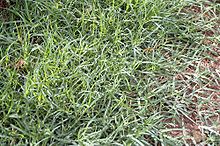Bermuda grass
| Cynodon dactylon | |
|---|---|
 |
|
| Scientific classification | |
| Kingdom: | Plantae |
| (unranked): | Angiosperms |
| (unranked): | Commelinids |
| Order: | Poales |
| Family: | Poaceae |
| Genus: | Cynodon |
| Species: | C. dactylon |
| Binomial name | |
|
Cynodon dactylon (L.) Pers. |
|
| Synonyms | |
|
List
|
|
Cynodon dactylon, also known as Vilfa stellatadūrvā grass, Dhoob, Bermuda grass, dubo, dog's tooth grass,Bahama grass, devil's grass, couch grass, Indian doab, arugampul, grama, wiregrass and scutch grass, is a grass that originated in the Middle East. Although it is not native to Bermuda, it is an abundant invasive species there. It is presumed to have arrived in North America from Bermuda, resulting in its common name. In Bermuda it has been known as crab grass.
The blades are a grey-green color and are short, usually 2–15 cm (0.79–5.91 in) long with rough edges. The erect stems can grow 1–30 cm (0.39–11.81 in) tall. The stems are slightly flattened, often tinged purple in colour.
The seed heads are produced in a cluster of two to six spikes together at the top of the stem, each spike 2–5 cm (0.79–1.97 in) long.
It has a deep root system; in drought situations with penetrable soil, the root system can grow to over 2 metres (6.6 ft) deep, though most of the root mass is less than 60 centimetres (24 in) under the surface. The grass creeps along the ground and roots wherever a node touches the ground, forming a dense mat. C. dactylon reproduces through seeds, runners, and rhizomes. Growth begins at temperatures above 15 °C (59 °F) with optimum growth between 24 and 37 °C (75 and 99 °F); in winter, the grass becomes dormant and turns brown. Growth is promoted by full sun and retarded by full shade, e.g., close to tree trunks.
Cynodon dactylon is widely cultivated in warm climates all over the world between about 30° S and 30° N latitude, and that get between 625 and 1,750 mm (24.6 and 68.9 in) of rainfall a year (or less, if irrigation is available). It is also found in the U.S., mostly in the southern half of the country and in warm climates.
Control/eradication
It is fast-growing and tough, making it popular and useful for sports fields, as when damaged it will recover quickly. It is a highly desirable turf grass in warm temperate climates, particularly for those regions where its heat and drought tolerance enable it to survive where few other grasses do. This combination makes it a frequent choice for golf courses in the southern and southeastern U.S. It has a relatively coarse-bladed form with numerous cultivars selected for different turf requirements. It is also highly aggressive, crowding out most other grasses and invading other habitats, and has become a hard-to-eradicate weed in some areas (it can be controlled somewhat with Triclopyr, Mesotrione, , and Glyphosate). This weedy nature leads some gardeners to give it the name of "devil grass". Bermuda grass is incredibly difficult to control in flower beds and most herbicides do not work. However, Ornamec, Ornamec 170 and Turflon ester (tricyclopyr) have shown some effectiveness as well as Imazapyr. All of these items are difficult to find in retail stores as they are primarily marketed to professional landscapers.
...
Wikipedia
